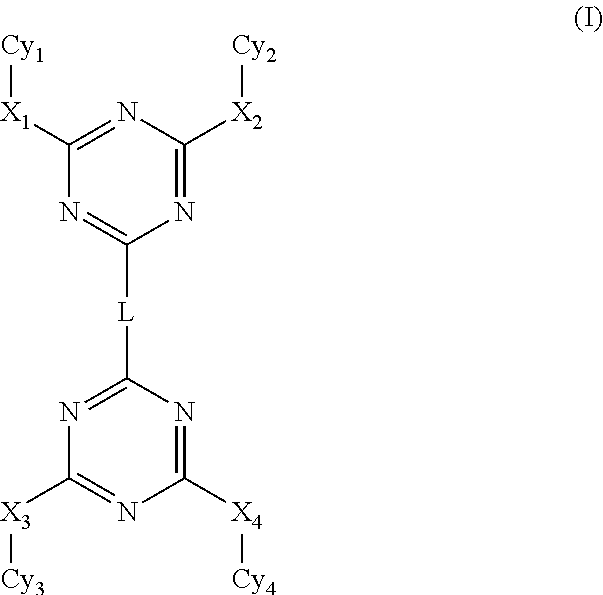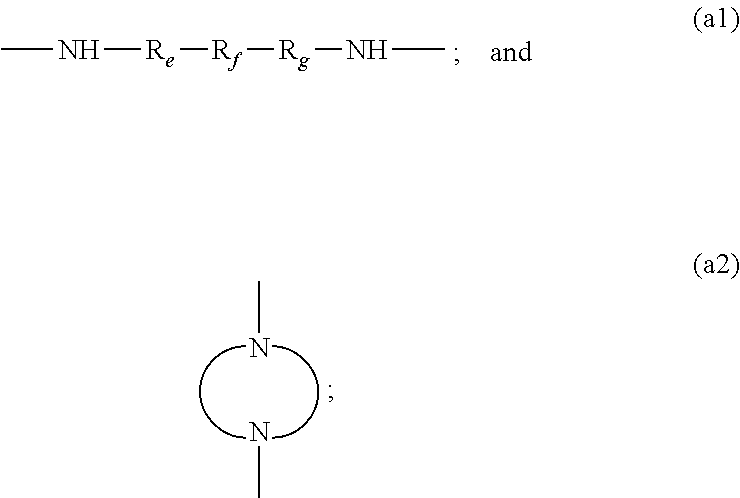Disubstituted triazine dimers for treatment and/or prevention of infectious diseases
a triazine dimer and triazine technology, applied in the direction of biocide, antiparasitic agents, drug compositions, etc., can solve the problems of neglected diseases not being satisfactory to be treated, and achieve the effects of less pronounced effect, low cytotoxicity value, and strong activity
- Summary
- Abstract
- Description
- Claims
- Application Information
AI Technical Summary
Benefits of technology
Problems solved by technology
Method used
Image
Examples
example 1
Specific Examples of Compounds According to the Invention
[0241]
CpdR1R2R3X1X2R4R5R6R7LinkerR8R9R10X3X4R11R12R13R14T1MeMeMeNHNHMeHMeMeHN(CH2)2NHMeMeMeNHNHMeHMeMeT2MeMeMeNHNHMeHMeMeHN(CH2)3NHMeMeMeNHNHMeHMeMeT3MeMeMeNHNHMeHMeMeHN(CH2)4NHMeMeMeNHNHMeHMeMeT4MeMeMeNHNHMeHMeMeHN(CH2)5NHMeMeMeNHNHMeHMeMeT5MeMeMeNHNHHHHCNHN(CH2)2NHMeMeMeNHNHHHHCNT6MeMeMeNHNHHHHCNHN(CH2)3NHMeMeMeNHNHHHHCNT7MeMeMeNHNHHHHCNHN(CH2)4NHMeMeMeNHNHHHHCNT8MeMeMeNHNHHHHCNHN(CH2)5NHMeMeMeNHNHHHHCNT9MeMeMeNHNHHHHCNHN(CH2)6NHMeMeMeNHNHHHHCNT10MeMeMeNHNHHHHCNHN(CH2)10NHMeMeMeNHNHHHHCNT11MeMeMeNHNHHHHCNMeMeMeNHNHHHHCNT12MeMeMeNHNHHHHCNMeMeMeNHNHHHHCNT13BrBrMeNHNHHHHCNHN(CH2)3NHBrBrMeNHNHHHHCNT14BrBrMeNHNHHHHCNHN(CH2)4NHBrBrMeNHNHHHHCNT15BrBrMeNHNHHHHCNHN(CH2)5NHBrBrMeNHNHHHHCNT16BrHMeNHNHHHHCNHN(CH2)2NHBrHMeNHNHHHHCNT17BrHMeNHNHHHHCNHN(CH2)3NHBrHMeNHNHHHHCNT18BrHMeNHNHHHHCNHN(CH2)5NHBrHMeNHNHHHHCNT19MeMeHNHNHHHHCNHN(CH2)2NHMeMeHNHNHHHHCNT20MeMeHNHNHHHHCNHN(CH2)3NHMeMeHNHNHHHHCNT21MeMeHNHNHHHHCNHN(CH2)5NHMeMeHNHNHHHHCNT22Me...
example 2
Synthesis of Intermediates I1-I2 and Target Compounds T1-T4
[0242]
6-chloro-N2,N4-dimesityl-1,3,5-triazine-2,4-diamine (I1)
[0243]To a solution of 2,4,6-trichloro-1,3,5-triazine (0.92 g, 5 mmol) in dioxane (30 mL) was added 2,4,6-trimethylaniline (1.4 mL, 10 mmol) and DIPEA (1.72 mL, 10 mmol) and allowed to reflux for 48 h. Removal of solvent and precipitation with 20% EtOAc in hexanes afforded white solid (1.2 g, 63%); 1H NMR (DMSO-d6, 400 MHz) δ 9.20 (s, 1H), 9.07 (s, 1H), 6.91 (s, 2H), 6.85 (s, 2H), 2.21 (s, 6H), 2.13 (s, 6H), 2.03 (s, 6H); MS (ESI) m / z 382 (M+H)+; LC-MS (214 nm) tr 19.8 min, 100
N2,N4-dimesityl-1,3,5-triazine-2,4,6-triamine (I2)
[0244]I1 (0.38 g, 1 mmol) was dissolved in 2M NH3 / dioxane (10 mL) in a pressure tube and allowed to stir at 100° C. overnight. Removal of solvent and purification by column chromatography using 60% EtOAc in hexanes afforded white solid (0.15 g, 41%); 1H NMR (DMSO-d6, 400 MHz) δ 7.84 (br s, 2H), 6.85 (br s, 4H), 6.20 (br s, 2H), 2.20-1.98 (m, ...
example 3
Synthesis of Intermediates I3-I5 and Target Compounds T5-T12
[0255]
4,6-dichloro-N-mesityl-1,3,5-triazin-2-amine (I3)
[0256]To a homogenous solution of 2,4,6-trichloro-1,3,5-triazine (3.69 g, 20 mmol) in dioxane (60 mL) was added K2CO3 (2.90 g, 21 mmol) and 2,4,6-trimethylaniline (2.96 mL, 21 mmol) and allowed to stir at room temperature for 36 h. Solvents were evaporated and water was added, extracted with EtOAc (3×100 mL), organic layers were washed with NaHCO3, brine and water, dried and evaporated gave light yellow solid (5.4 g, 95%)
[0257]1H NMR (DMSO-d6, 400 MHz) δ 10.4 (s, 1H), 6.94 (s, 2H), 2.25 (s, 3H), 2.10 (s, 6H); MS (ESI) m / z 283 (M+H)+
4-((4-chloro-6-(mesitylamino)-1,3,5-triazin-2-yl)amino)benzonitrile (I4)
[0258]To a solution of I3 (0.99 g, 3.5 mmol) in dioxane (30 mL) was added DIPEA (0.64 mL, 3.85 mmol) and 4-aminobenzonitrile (0.41 g, 3.5 mmol) and allowed to stir at 120° C. over weekend. Concentration of the reaction mixture and extraction with EtOAc followed by brine w...
PUM
| Property | Measurement | Unit |
|---|---|---|
| Composition | aaaaa | aaaaa |
| Therapeutic | aaaaa | aaaaa |
Abstract
Description
Claims
Application Information
 Login to View More
Login to View More - R&D
- Intellectual Property
- Life Sciences
- Materials
- Tech Scout
- Unparalleled Data Quality
- Higher Quality Content
- 60% Fewer Hallucinations
Browse by: Latest US Patents, China's latest patents, Technical Efficacy Thesaurus, Application Domain, Technology Topic, Popular Technical Reports.
© 2025 PatSnap. All rights reserved.Legal|Privacy policy|Modern Slavery Act Transparency Statement|Sitemap|About US| Contact US: help@patsnap.com



